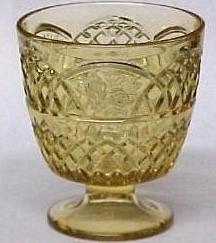
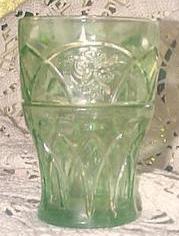
Federal's Mayfair & Rosemary Patterns
Written by Rosemary Trietsch
I’m often asked if I collect “Rosemary” since that’s my name - I’m sure ‘Sharons’ hear the same thing. Well, I must admit that I don’t. No, really. (Stop shaking your head – I’m serious. I don’t have a single piece.) The pattern never really grabbed my attention, though I must admit I don’t run across very much of it and what little I do find is amber, which really doesn’t grab my attention either. I don’t mean to offend collectors of Rosemary or amber glass – it’s just that neither is really my ‘thing.’ But just because I don’t collect it doesn’t mean that I’m not intrigued by the pattern. Rosemary is the end result of Federal Glass’ perseverance through copyright problems and redesigned molds. (Me, I’m the end result of my parents’ perseverance, and I’m careful to avoid copyright problems: though I’m trying to redesign the mold through toning and strength training….) Before I get into any more trouble, let’s talk about glass.
In 1934 Federal Glass Company introduced a pattern they called Mayfair. It was advertised in one issue of the Crockery and Glass Journal and available in “Golden Glow” (amber) and crystal. Unfortunately Federal was a little premature in it’s marketing: the patent office refused their application as Hocking already held the copyright on the name ‘Mayfair.’ As they had already advertised the pattern under the Mayfair name, Federal was forced to redesign it before they could reissue it. The pattern was redone at least twice before Federal finally patented “Rosemary” in 1935. But after all the effort involved, production ended by 1937 as Federal chose to put its energy and resources into its other rose pattern, Sharon.


Mayfair
and Rosemary are examples of a work in progress. By studying the two together
and seeing their similarities and differences, you can trace the development of
an idea from beginning to end. What makes the metamorphosis from Mayfair to
Rosemary especially interesting is that a transitional pattern exists with
characteristics of both. Let’s start at the beginning. Weatherman says that
the original Mayfair pattern was designed by a jeweler in Columbus, Ohio (BK1,
pg.113) and its intricate facets certainly make it sparkle like a jewel, giving
credence to this statement. The
primary design is arched panels that are decorated alternately with two open
roses and a honeycomb pattern. (The honeycombed sections remind me of a
cathedral window.) The edges of the plates and flat rimmed bowls are scalloped
to follow this arched design. The center area on these pieces has the honeycomb
design in a sunburst – like the ones you could make on a Spirograph if you
were really careful. (Remember?) This sunburst translates into a waffle pattern
around the bottom of the sugar & creamer, cup, tumbler, and cream soup bowl.
This original Mayfair pattern from 1934 was only made in crystal and amber.
The Rosemary pattern that came out in 1935 retained the arches and the two open roses, but the honeycomb design and waffling were gone. The central sunburst was replaced with a larger open rose design that echoes the two roses found under the arches circling the edge. In this simplified version of Mayfair, the roses become the focus of the pattern and have earned Rosemary the nickname “Dutch Rose.” Although the pieces retain the same basic shapes as Mayfair, the edges are smooth instead of scalloped, making them look more like Federal’s Sharon pattern. Amber, called “Golden Glow” in the advertisements, was the most plentiful color produced and is most easily found today. “Springtime Green” and “Rose Glow”(pink) were also made during it’s brief production, but both are so scarce today that it must have been a very limited run.
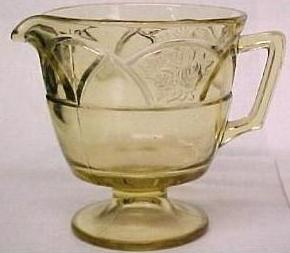
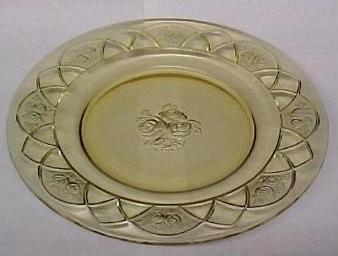
At
some point in 1934, when the copyright problem became apparent, Federal began
the change from Mayfair to Rosemary. What’s interesting is that they produced
a hybrid pattern with characteristics of both during this very short time
period. The transitional pieces have round edges and plain arches like Rosemary,
but they also have a simplified waffle pattern around the bottoms of cups,
tumblers, sugars & creamers, and cream soups like Mayfair. Gene Florence
suggests that these extra arches made the new pattern too similar to the old and
so were dropped from the final design. He considers these transitional pieces a
variation of Mayfair and includes them in the Mayfair listing in his books.
Weatherman is of a different opinion. In the Rosemary listing of her 1983 Price
Trends she writes, “Don’t lose
any sleep over the fact that your cups, tumblers, creams, sugars or even other
pieces have slight variations in the pattern – many do, it seems…. Some
Rosemary pieces have an extra row of arches, right below the arches we already
know and love. We’ll distinguish this variation from the standard by calling
it ‘Rosemary Arches.’ You might
confuse it with Federal’s Mayfair pattern, incidentally, but it doesn’t
match Mayfair at all.” I tend to agree with Weatherman on this one and
here’s why: The transitional pieces are found in amber and green. As Mayfair
was not made in green, (Florence even says that green Mayfair “can only be
bought in the transitional form”) it seems more logical to me that they’re
part of the Rosemary line than a variation of the Mayfair pattern. After all,
you can’t have a variation/transitional piece of something that wasn’t made.
Together, Mayfair and Rosemary were only available for a very brief 3-year period. When you consider that part of that time was taken up with copyright problems and redesigning the molds, the actual production period was even shorter than that. Today’s collectors have their work cut out for them, as a set in either pattern is a challenge to assemble. The same 13 pieces are available in both Mayfair and Rosemary. Both were originally sold in sets that included the cup, saucer, 5” berry bowl, dinner and luncheon plate, and these 5 pieces are somewhat available today – in amber, that is. Pink and green are another story. The grill plate, 6 inch cereal bowl, cream soup bowl and 9 oz tumbler were available to expand the set, but all are scarce today. Serving pieces are limited to an oval vegetable bowl, oval platter, and the sugar and creamer. The sugar bowl is often mislabeled as a sherbet because it has no handles, and for reasons unknown, you’ll often find them in bunches rather than alone with a creamer. People must have been able to buy them individually (rather than only as a set) and used them for desert dishes. Otherwise, there were a lot of creamers sacrificed in the name of Rainbow sherbet.
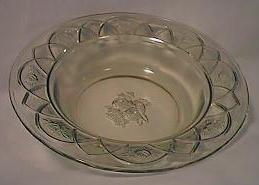
Mayfair and Rosemary are harder to find than their ‘book’ price would suggest. This is certainly an example of how fewer collectors searching for a smaller pattern has kept most prices within reach. But the problem is not the price of the pieces – it’s finding them at all. Cream soups, tumblers, 6-inch cereal bowls, and the oval bowl and platter are very hard to find in any color. Grab them immediately if you should be lucky enough to find them, as you probably won’t have a second chance anytime soon. With luck and perseverance, a set can be assembled in amber - more easily if you include the transitional pieces as part of either Mayfair or Rosemary. The ‘Rosemary Arches’ pieces also help green Rosemary collectors assemble enough dishes to use within this lifetime. Pink Rosemary is becoming virtually invisible. Putting a set together may become a project you pass on to future generations: sort of a family legacy. Just think, 60 years from now your grandchildren can continue the search for pink Rosemary cream soup bowls and tumblers. You will have done something to bridge the generations, keeping your memory and collection alive for years to come. Of course, your descendants will probably look at it a little differently – more like a family curse.
Happy Collecting!
Sources:
Gene Florence, Collector’s Encyclopedia
of Depression Glass, 13th Edition
Hazel Marie Weatherman, Colored
Glassware of the Depression Era, 1970
1983 Supplement and Price Trends
Sandra McPhee Stout, Depression
Glass In Color, 1970